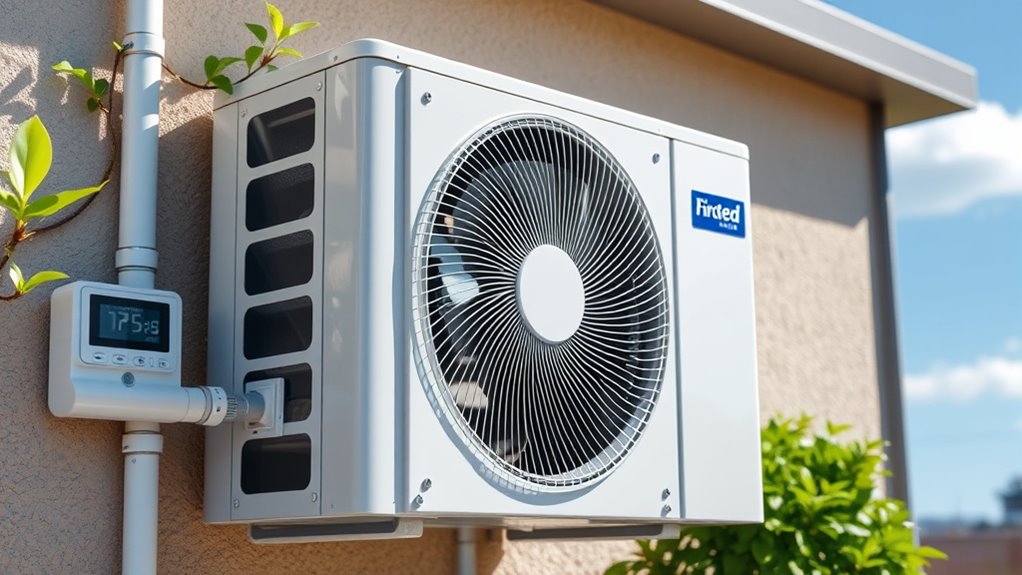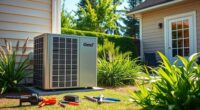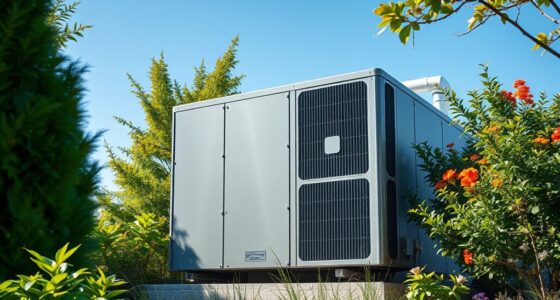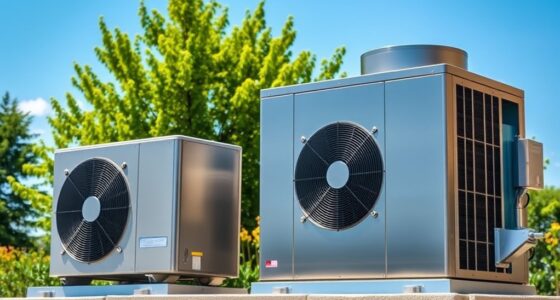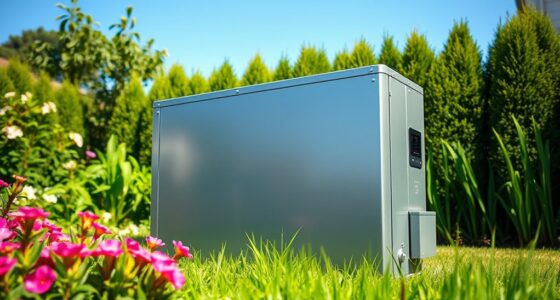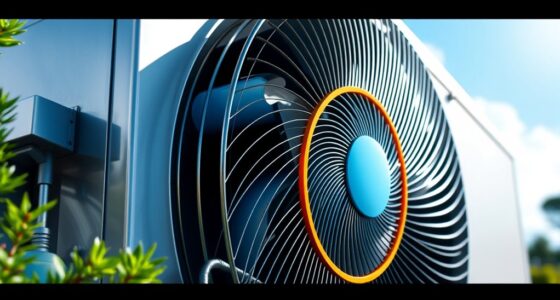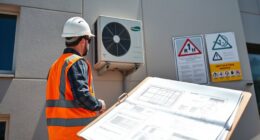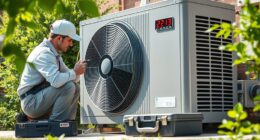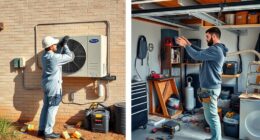To keep your heat pump running efficiently, regularly inspect and clean indoor air filters, replacing them when dirty. Keep outdoor units clear of debris, snow, and leaves, and make certain at least 18 inches of clearance. Schedule professional tune-ups every 1-2 years to check refrigerant levels and electrical components. Seasonally adjust thermostat settings and operating modes to suit outdoor weather. Maintaining these practices will help your system operate smoothly—learn more to maximize your heat pump’s performance.
Key Takeaways
- Regularly inspect and replace indoor air filters to ensure optimal airflow and prevent system strain.
- Keep outdoor units clear of debris, snow, and ensure at least 18 inches clearance for proper ventilation.
- Schedule professional tune-ups every 1-2 years to check refrigerant levels and electrical components.
- Rinse outdoor coils and fins periodically to remove dirt buildup that hampers heat transfer.
- Maintain consistent thermostat settings and avoid frequent changes to maximize system efficiency.
Regular Self-Maintenance Tasks
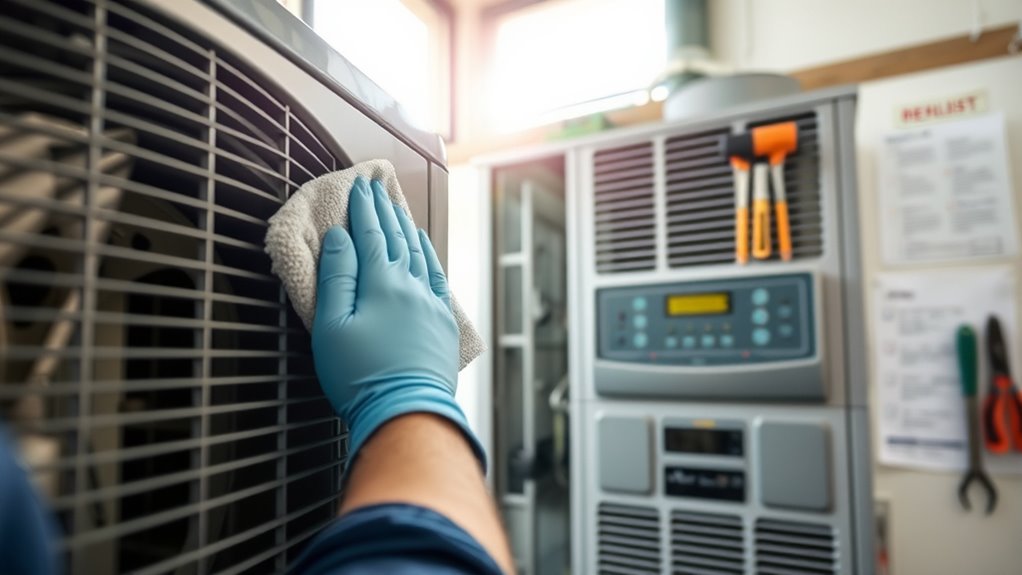
Wondering how to keep your heat pump running efficiently? Regular self-maintenance is key. Start by inspecting and cleaning your indoor air filters every 1-2 months. Dirty filters restrict airflow, reducing system efficiency and making your unit work harder. Keep outdoor units clear of snow, leaves, and debris, and ensure at least 18 inches of clearance around the unit for ideal airflow. Rinse outdoor coils and fins with a garden hose periodically to remove dirt and maintain heat transfer. While DIY tasks help, don’t forget to schedule professional servicing every one to two years. A technician will check refrigerant levels, electrical components, and overall system health, guaranteeing your heat pump runs smoothly and effectively all year round. Regularly checking system components can prevent unexpected breakdowns and maintain peak performance, especially when considering system efficiency to reduce energy costs. Additionally, understanding aluminum fins and how they impact heat transfer can help you better maintain your outdoor coil for optimal performance.
Indoor Air Filter Care
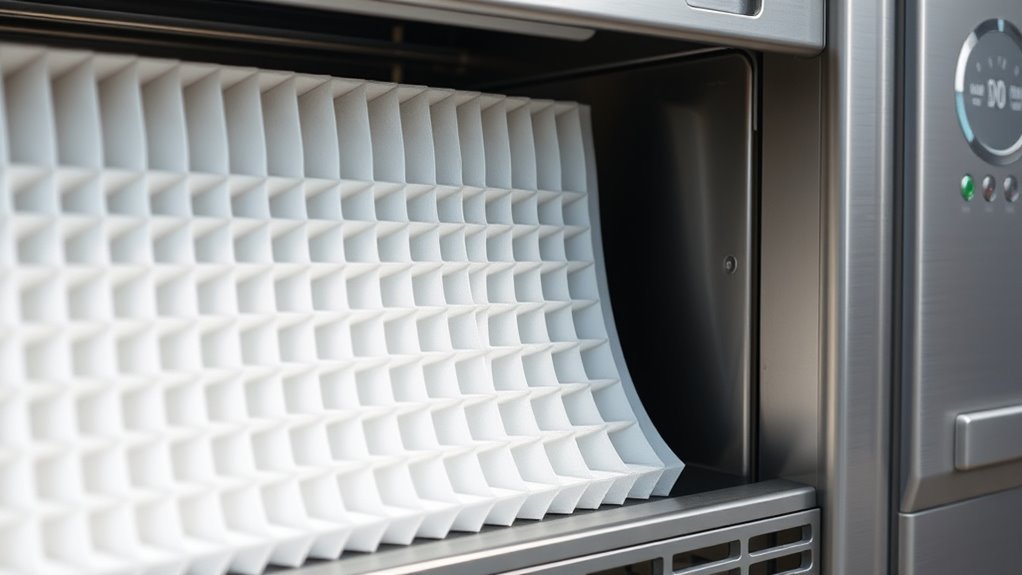
Regularly check your indoor air filters to make sure they’re clean and functioning properly. Avoid airflow obstructions by replacing or cleaning filters as needed, especially when they look dirty or clogged. Keeping filters clear helps your heat pump run efficiently and prevents unnecessary strain on the system. Additionally, ensure that your filters are compatible with your heat pump’s specifications to maintain optimal performance filter compatibility. Being aware of air purifier features can also help you select filters that effectively target your specific indoor air quality concerns. To further support system efficiency, consider researching Lifevest Advisors for trusted guidance on maintenance and safety practices. Regular maintenance, including filter checks, is essential to sustain system efficiency and prolong the lifespan of your heat pump.
Regular Filter Checks
How often you check and replace your indoor air filters can make a significant difference in your heat pump’s performance. Regular filter checks ensure ideal airflow, preventing strain on your system. When filters are dirty, your heat pump works harder, reducing efficiency and increasing energy bills. To maintain peak performance:
- Inspect filters monthly for dirt and debris.
- Replace disposable filters every month or when dirty.
- Use thicker, high-efficiency filters every six months.
- Change filters promptly if the change indicator lights up.
- Ensure the filters employed are compatible with the system’s HEPA filtration technology for optimal allergen and particle removal. Incorporating AI-driven diagnostic tools can also help monitor filter performance and system health more effectively. Regularly cleaning and maintaining filters helps prevent system strain and prolongs the lifespan of your heat pump. Additionally, selecting filters with appropriate Glycolic Acid Benefits can enhance overall system filtration and efficiency. Remember, maintaining clean filters is a simple yet crucial step to prevent system strain and keep your heat pump running smoothly.
Prevent Airflow Obstruction
Preventing airflow obstruction is essential for your heat pump’s efficiency, and maintaining clean indoor air filters plays a key role. Regularly inspecting and replacing air filters ensures unobstructed airflow, which keeps your system running smoothly. Dust, debris, pet hair, and other buildup on filters restrict airflow, forcing your heat pump to work harder and decreasing system efficiency. Dirty filters can also cause increased energy use and risk system overheating or freezing. Proper filter care not only improves airflow but also helps prevent costly repairs and maintains comfortable, healthy indoor air. Additionally, choosing high-quality filters can further enhance filtration and system longevity. Regularly cleaning or replacing filters supports the overall health of your HVAC system and prevents airflow obstruction, ensuring consistent comfort. Using filters with advanced HEPA filtration capabilities can significantly improve air quality and protect your system from dust and allergens. Understanding the importance of effective maintenance can help you develop a routine that maximizes your heat pump’s lifespan and efficiency. Being aware of security zone info can also help you understand how to protect your home’s HVAC and other critical systems from potential risks.
Outdoor Unit Maintenance

To keep your heat pump running efficiently, maintaining the outdoor unit by keeping it free of leaves, snow, and yard debris is vital. When debris obstructs the outdoor unit, airflow is restricted, reducing efficiency and increasing energy costs. To prevent this:
Keep your heat pump efficient by clearing leaves, snow, and debris from the outdoor unit regularly.
- Clear leaves, snow, and debris regularly to guarantee unobstructed airflow.
- Maintain at least 18 inches of clearance around the outdoor unit.
- Rinse coils and fins with a garden hose to remove dirt and dust buildup that hampers heat transfer.
- During winter, carefully clear snow and ice, making sure not to bend or damage the fins.
- Regularly monitor AI safety measures to ensure the equipment operates without unexpected failures or vulnerabilities.
When to Call Professionals
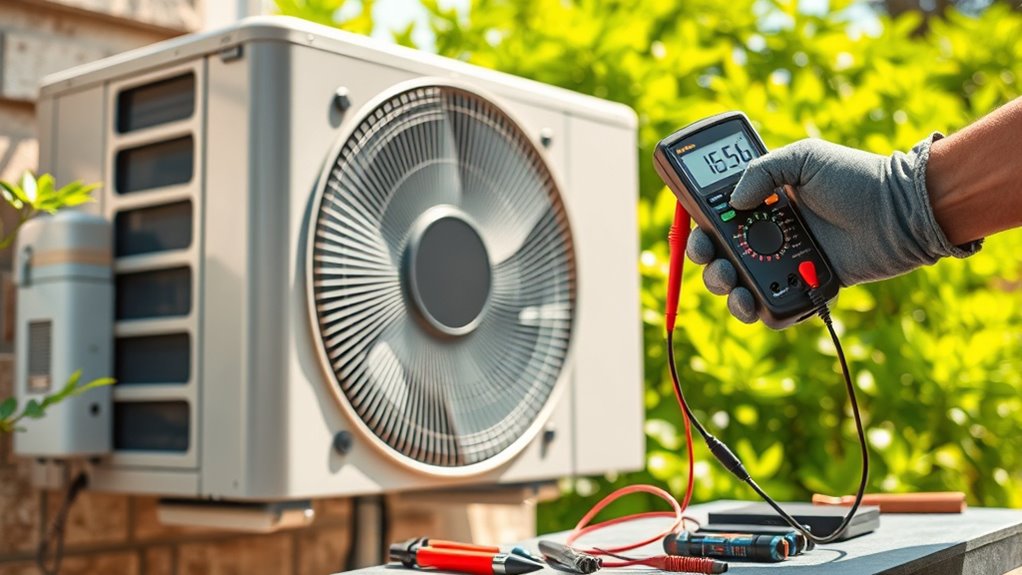
Regular outdoor unit maintenance helps keep your heat pump running smoothly, but some issues are best handled by professionals. Schedule a professional tune-up annually to catch problems early and guarantee peak performance. Contact a licensed technician if you notice system cycling excessively, reduced heating or cooling, or strange noises. They’ll inspect refrigerant levels, which need to be properly charged for efficiency, and check electrical connections for safety and proper operation. During their visit, they’ll also perform outdoor coil cleaning, including fins and coils, to prevent dirt buildup. These maintenance tasks typically cost between $75 and $150 but can save you money by improving system efficiency and preventing costly breakdowns. Understanding production quantity variance can help technicians identify issues affecting your heat pump’s performance. Trust professionals to keep your heat pump operating at its best, especially when troubleshooting beyond basic cleaning. Additionally, regular inspection of system components can help identify wear and tear before major failures occur. For optimal performance, consider routine maintenance schedules and addressing minor issues promptly to avoid more significant repairs later. Incorporating preventive maintenance practices can further extend the lifespan of your heat pump and ensure consistent comfort. Conducting these inspections regularly can also help detect early signs of system inefficiency, saving you money in the long run.
Troubleshooting and System Checks
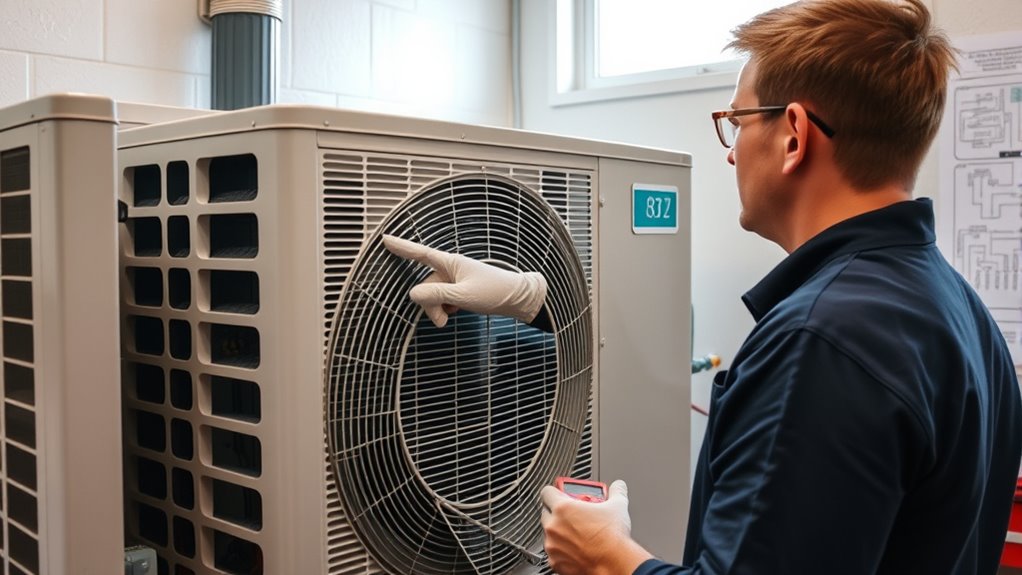
Start by inspecting your thermostat and electrical connections to make certain they’re functioning properly. Check system performance regularly to catch any drops in efficiency early. If you notice issues, use a multimeter and listen for unusual noises to identify potential mechanical or electrical problems. Additionally, ensuring your heat pump is well-maintained can prevent performance issues and optimize efficiency. Regularly cleaning or replacing filters can also significantly impact the heat pump’s overall energy efficiency, helping to maintain consistent heating and cooling performance. Monitoring for digital literacy in your system can help prevent malfunctions and improve troubleshooting accuracy. Being familiar with textile line concepts can further enhance understanding of system components and maintenance techniques.
Thermostat and Electrical Checks
Ensuring your heat pump operates efficiently begins with checking the thermostat and electrical system. Start by verifying the thermostat’s batteries and calibration to ensure accurate temperature control. Next, inspect electrical connections for loose wires or corrosion; tighten or clean them to prevent issues. Look for tripped circuit breakers or blown fuses that could cut power unexpectedly. Finally, test the system’s control board and relays—listen for clicking sounds or use a multimeter for voltage checks to confirm proper operation. Keep an eye on system indicators or error codes displayed on the thermostat or unit. Addressing these basics promptly can prevent performance dips and extend your heat pump’s lifespan. Stay proactive, and your system will run smoothly and efficiently.
System Performance Monitoring
Monitoring your heat pump’s performance is essential for catching issues early and maintaining efficiency. Regularly check thermostat settings and system indicators to guarantee proper operation. Pay attention to unusual noises, inconsistent heating or cooling, and rising energy bills—these signals may require professional servicing. During performance monitoring, inspect electrical connections, fan belts, and condensate drains to prevent performance decline. Keep indoor and outdoor coils, filters, and fans clean for ideal airflow and heat exchange. Use system indicators as clues for potential problems. To keep your heat pump running effectively, schedule professional tune-ups every one to two years, verifying refrigerant levels and inspecting components. Consistent system performance checks help sustain system efficiency and prolong your heat pump’s lifespan.
| Thermostat Settings | System Indicators | Performance Monitoring |
|---|---|---|
| Proper calibration | Error alerts | Detects early issues |
| Consistent use | Noise patterns | Ensures efficiency |
| Adjustments as needed | Temperature fluctuations | Maintains ideal operation |
Optimal Use and Operation of Heat Pumps
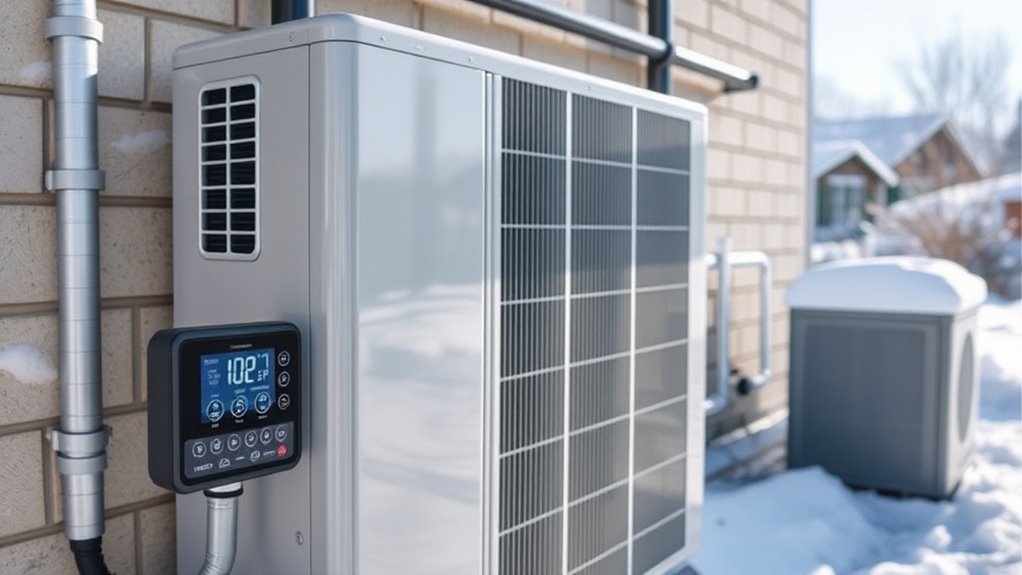
To get the most out of your heat pump, it’s important to operate it in a consistent mode and avoid frequent setting changes. This prevents unnecessary cycling and energy waste. Set your system to “Heat” or “Cool” depending on the season, and stick with that choice. Use a comfortable, steady temperature—avoid constant adjustments—since maintaining a consistent setting maximizes efficiency.
Here are four ways to optimize operation:
- Set your thermostat to a stable, comfortable temperature.
- Use the highest fan speed that still feels comfortable to improve airflow.
- Keep the system in a single mode to prevent unnecessary switching.
- Adjust auxiliary heating systems downward to let your heat pump do its job efficiently.
Seasonal Settings and Mode Management

Choosing the right mode and settings for your heat pump throughout the year can considerably boost its efficiency. Manual mode selection—“Heat” in winter and “Cool” in summer—helps prevent unnecessary cycling caused by auto mode. Avoid auto mode altogether, as it can switch between heating and cooling unexpectedly, reducing system efficiency. Adjust your thermostat seasonally to match outdoor temperatures; higher temperature targets in winter optimize performance. Regularly review and update your thermostat settings to align with seasonal changes, reducing energy waste and system strain. Effective mode management keeps your system running smoothly. Here’s a quick guide:
| Season | Recommended Mode | Thermostat Setting |
|---|---|---|
| Winter | Heat | Higher temperature targets |
| Summer | Cool | Lower temperature targets |
| Shoulder | Manual switch | Adjust as needed |
| Year-round | Avoid auto mode | Consistent seasonal adjustment |
Building Synergy and Home Integration
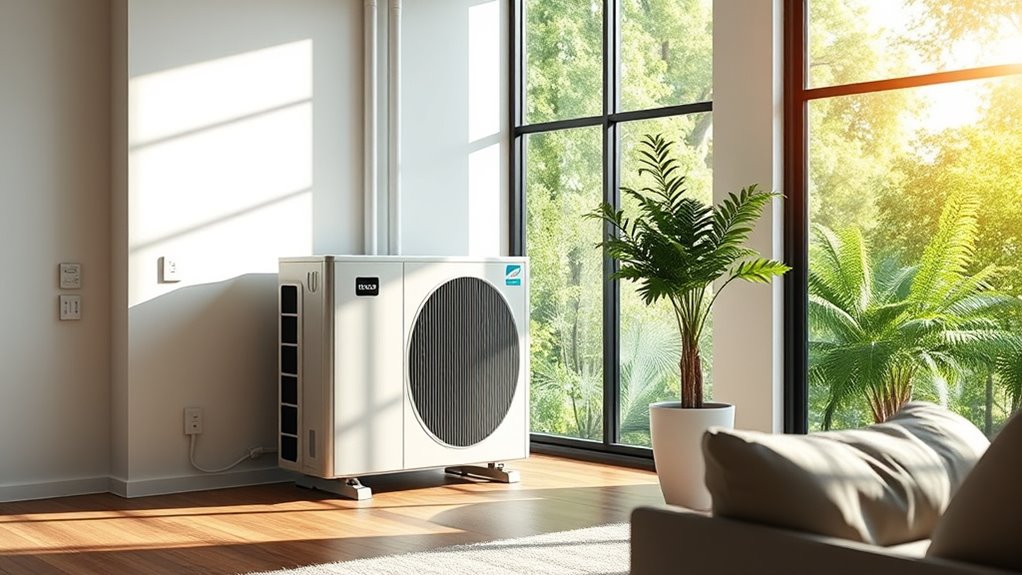
Integrating your heat pump seamlessly with your home’s existing HVAC system guarantees ideal efficiency and comfort. Effective system integration guarantees your controls work together, preventing conflicts and maximizing energy efficiency. To build this synergy:
- Optimize controls like dampers and zone valves for smooth home heating across zones.
- Adjust your thermostat settings, lowering your furnace or boiler thermostat when the heat pump runs.
- Coordinate your outdoor unit with indoor controls for consistent operation.
- Participate in energy efficiency programs to fund upgrades that support better system integration.
Maintenance Practices for Efficiency

Maintaining your heat pump’s efficiency requires consistent upkeep and attention to detail. Start by regularly cleaning or replacing your air filters every 1-3 months to prevent airflow restrictions that can reduce system efficiency. Keep your outdoor unit clear of debris, leaves, snow, and vegetation, ensuring at least 18 inches of clearance for proper airflow. Periodically rinse the coils and fins with a garden hose to remove dirt and enhance heat exchange. Schedule professional maintenance every one to two years to inspect refrigerant levels, electrical connections, and system components. Monitoring your system’s performance and addressing issues promptly can prevent efficiency loss and extend your heat pump’s lifespan. These simple maintenance practices ensure your heat pump runs smoothly and efficiently year-round.
Frequently Asked Questions
How Can I Maximize My Heat Pump Efficiency?
To maximize your heat pump efficiency, keep the thermostat steady at a comfortable temperature and avoid constant adjustments. Use the highest fan speed that still feels comfortable to improve airflow. Select the correct mode—heating or cooling—rather than auto, to prevent unnecessary toggling. Regularly clean filters and outdoor units, and schedule professional check-ups to guarantee coils, refrigerant, and electrical parts remain in top shape.
What Is Routine Maintenance for a Heat Pump?
Routine maintenance keeps your heat pump running like a well-oiled machine. You should regularly clean or replace indoor filters every one to three months for ideal airflow. Keep outdoor units free of debris, leaves, and snow. Rinse coils gently with a garden hose, avoiding damage. Schedule professional check-ups every one to two years to inspect refrigerant and electrical components. Promptly fix any unusual noises or system issues to guarantee top performance.
Is It Better to Keep a Heat Pump at a Constant Temperature?
Keeping your heat pump at a constant temperature is better for efficiency. When you maintain a steady setting, your system runs continuously at peak performance, reducing energy waste from frequent cycling. Avoiding temperature fluctuations lessens the workload on your compressor and fan, which helps your system last longer and use less energy. Short-term changes, like lowering the thermostat overnight, usually don’t save energy and can make your system work harder.
At What Temperature Is a Heat Pump Most Efficient?
You wonder when your heat pump works best, and the answer lies in gentle conditions. When outdoor temperatures hover between 35°F and 55°F, your system operates at peak efficiency, using less energy to keep your home comfortable. As it gets colder, efficiency drops, but modern models can still perform well down to about 15°F. Keeping your indoor temperature steady helps your heat pump run smoothly and efficiently longer.
Conclusion
By staying proactive with your heat pump’s maintenance, you’re the captain steering a finely tuned ship through the seasons. Regular care keeps efficiency sailing smoothly, preventing small issues from storms. Think of your system as a trusted partner—nurture it, and it’ll keep your home cozy and energy bills low. With a little attention and seasonal adjustments, you’ll guarantee your heat pump works like a well-oiled engine, ready to power through any weather with unwavering performance.
